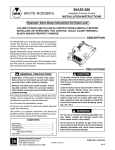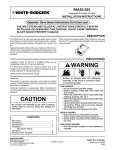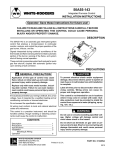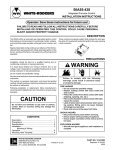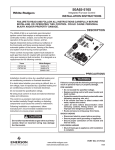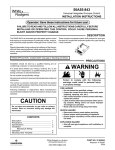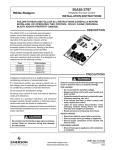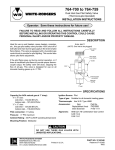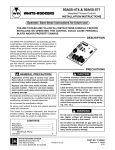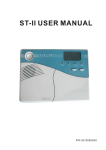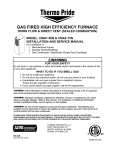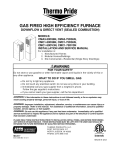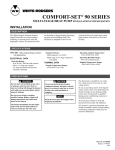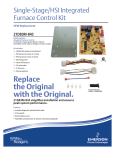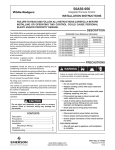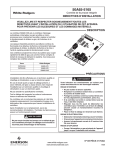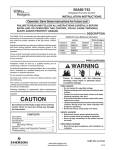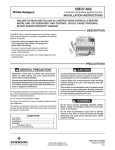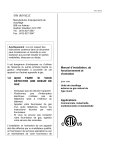Download White Rodgers 50A62-820 User's Manual
Transcript
50A62-820 WHITE-RODGERS Integrated Furnace Control INSTALLATION INSTRUCTIONS Operator: Save these instructions for future use! FAILURE TO READ AND FOLLOW ALL INSTRUCTIONS CAREFULLY BEFORE INSTALLING OR OPERATING THIS CONTROL COULD CAUSE PERSONAL INJURY AND/OR PROPERTY DAMAGE. DESCRIPTION The 50A62-820 is an automatic gas interrupted ignition control that employs a microprocessor to continually monitor, analyze, and control the proper operation of the gas burner, inducer, and fan. Signals interpreted during continual surveillance of the thermostat and flame sensing element initiate automatic ignition of the burner, sensing of the flame, and system shut-off during normal operation. These controls incorporate system fault analysis for quick gas flow shut-off, coupled with automatic ignition retry upon sensing a fault correction. PRECAUTIONS ! CAUTION ! GENERAL PRECAUTION Application of this type of control may cause flame rollout on initial start-up and could cause personal injury and/or property damage. Replace only with exact model number, including dash number. Failure to use exact replacement control could cause personal injury and/or property damage. If in doubt about whether your wiring is millivolt, line, or low voltage, have it inspected by a qualified heating and air conditioning contractor, or licensed electrician. Do not exceed the specification ratings. To prevent electrical shock and/or equipment damage, disconnect electric power to system at main fuse or circuit breaker box until installation is complete. Label all wires prior to disconnection when servicing controls. Wiring errors can cause improper and dangerous operation. This control is not intended for use in locations where it may come in contact with water. Suitable protection must be provided to shield the control from exposure to water (dripping, spraying, rain, etc.). All wiring must conform to local and national electrical codes and ordinances. This control is a precision instrument, and should be handled carefully. Rough handling or distorting components could cause the control to malfunction. CONTENTS Description ......................................................... Precautions ........................................................ Specifications ..................................................... Installation .......................................................... Mounting & Wiring Operation ........................................................... WHITE-RODGERS EMERSON ELECTRIC CO. 9797 REAVIS ROAD ST. LOUIS, MISSOURI 63123-5398 www.white-rodgers.com 1 1 2 3 ! WARNING Do not use on circuits exceeding specified voltage. Higher voltage will damage control and could cause shock or fire hazard. Do not short out terminals on gas valve or primary control to test. Short or incorrect wiring will damage thermostat and could cause personal injury and/or property damage. 6 PART NO. 37-6266A Printed in U.S.A. 0119 SPECIFICATIONS ELECTRICAL RATINGS [@ 77°F (25°C)]: Input Voltage: 25 VAC 50/60 Hz Max. Input Current @ 25 VAC: 0.455 amp Relay Load Ratings: Valve Relay: 1.5 amp @ 25 VAC 50/60 Hz 0.6 pf Ignitor Relay: 2.0 amp @ 120 VAC 50/60 Hz (resistive) Flame Current Requirements: Minimum current to insure flame detection: 1 µa DC* Maximum current for non-detection: 0.1 µa DC* Maximum allowable leakage resistance: 100 M ohms TIMING SPECIFICATIONS (All times are in seconds, unless noted otherwise) 50A62-820 PRE-PURGE 15 TRIAL FOR IGNITION PERIOD 4 IGNITION ACTIVATION PERIOD 4 RETRIES *Measured with a DC microammeter in the flame probe lead 4 times VALVE SEQUENCE PERIOD 12 OPERATING TEMPERATURE RANGE: -40° to 175°F (-40° to 80°C) INTERPURGE 15 POST-PURGE 5 HUMIDITY RANGE: 5% to 93% relative humidity (non-condensing) LOCKOUT TIME 122 HEAT DELAY-TO-FAN-ON 45 MOUNTING: Surface mount multipoise HEAT DELAY-TO-FAN-OFF* Timing Specs: (@ 60 Hz) Flame Establishing Time: Flame Failure Response Time: maximum 2 sec 2 sec Gases Approved: Natural, Manufactured, Mixed, Liquid Petroleum, and LP Gas Air Mixtures are all approved for use. 2 60/90/ 120/180 COOL DELAY-TO-FAN-ON 0 COOL DELAY-TO-FAN-OFF 0 IGNITOR WARM-UP 20 HUMIDIFIER YES ELECTRONIC AIR CLEANER YES * This time will vary depending on option switch position. The control is factory-set at 60 sec. heat delay-to-fan-off. See OPERATION section for further information. INSTALLATION MOUNTING AND WIRING ! WARNING NOTE Replace 50A62 control as a unit - no user serviceable parts. Do not use on circuits exceeding specified voltage. Higher voltage will damage control and could cause shock or fire hazard. All wiring should be installed according to local and national electrical codes and ordinances. ! CAUTION The control must be secured to an area that will experience a minimum of vibration and remain below the maximum ambient temperature rating of 175°F. The control is approved for minimum ambient temperatures of -40°F. The 50A62 control may be mounted only in a control box of a Lennox furnace. To prevent electrical shock and/or equipment damage, disconnect electric power to system at main fuse or circuit breaker box until installation is complete. Any orientation is acceptable. Failure to earth ground the appliance or reversing the neutral and hot wire connection to the line can cause shock hazard. Refer to the wiring diagram and wiring table when connecting the 50A62 control to other components of the system. Shut off main gas to heating system until installation is complete. UL approved, 105°C rated 18 gauge, stranded, 2⁄64” thick insulation wire is recommended for all low voltage safety circuit connections. Refer to 50A62 specification sheet for recommended terminals to mate with those on the control. Route and secure all wiring as far from flame as practical to prevent fire and/or equipment damage. UL approved 105°C rated 16 gauge min., stranded, 4⁄64” thick insulation wire is recommended for all line voltage connections. Refer to 50A62 specification sheet for recommended terminals to mate with those on the control. After installation or replacement, follow appliance manufacturer’s recommended installation or service instructions to ensure proper operation. 3 TYPICAL SYSTEM WIRING DIAGRAM HOT (LINE) NEUTRAL (LINE) 120 VAC 24 VAC CLASS II TRANSFORMER TH 24 VAC TR 50A62 COOL HEAT FAN M1 M2 LINE XFMR EAC HUM CIRCULATOR BLOWER INDUCER IND IGN IGNITOR HUMIDIFIER GND GND ELECTRONIC AIR CLEANER CIR N LINE N XFMR N HUM N EAC N Y Y W W G G R R C FLAME SENSOR PROBE THERMOSTAT FP PRESSURE SWITCH (N. O.) PS PS HL RO1 GND RO2 MV MV TR TH LEGEND Low Voltage (24 VAC) Line Voltage (120 VAC) N. C. = Normally closed switch N. O. = Normally open switch 4 COMPRESSOR CONTACTOR HIGH LIMIT (N. C.) ROLLOUT (N. C.) GAS VALVE TYPICAL SYSTEM WIRING TABLE 50A62 TERMINAL TERMINAL TYPE SYSTEM COMPONENT CONNECTION W captive screw low voltage thermostat W terminal (or equivalent) G R captive screw low voltage thermostat G terminal (or equivalent) low voltage thermostat R terminal (or equivalent) captive screw Y C low voltage thermostat Y terminal (or equivalent) captive screw 2nd wire from Y terminal goes to 24 VAC HOT side of compressor contactor coil captive screw 24 VAC COMMON side of compressor contactor coil MV (2 terminals) RO1 gas valve (both gas solenoids are connected in parallel) rollout switch OUTPUT RO2 rollout switch INPUT PS PS GND 9-pin connector & harness HL pressure switch INPUT pressure switch OUTPUT MUST BE RELIABLY GROUNDED TO CHASSIS high limit switch input (unused terminal) IND IGN GND GND (unused 2 terminals) COOL HEAT M1 M2 FAN LINE XFMR CIR N LINE N XFMR N HUM EAC (optional) HUM N EAC N (optional) TR TH FP inducer HOT side 6-pin connector & harness spade terminal spade terminal spade terminal spade terminal spade terminal spade terminal spade terminal spade terminal spade terminal spade terminal spade terminal spade terminal spade terminal spade terminal spade terminal spade terminal spade terminal ignitor HOT side inducer NEUTRAL side ignitor NEUTRAL side circulator blower COOL SPEED terminal circulator blower HEAT SPEED terminal unused circulator blower terminal unused circulator blower terminal circulator blower FAN SPEED terminal input voltage (120 VAC) HOT side 24 VAC transformer line voltage HOT side circulator blower NEUTRAL terminal input voltage (120 VAC) NEUTRAL side 24 VAC transformer line voltage NEUTRAL side humidifier HOT side electronic air cleaner HOT side humidifier NEUTRAL side electronic air cleaner NEUTRAL side 24 VAC transformer (low voltage COMMON side) 24 VAC transformer (low voltage HIGH side) flame sensor port* * maximum recommended flame probe wire length is 36 inches. 5 OPERATION OPTION SWITCHES The option switches on the 50A62-820 control are used to determine the length of the heat delay-to-fan-off period. The following table shows the time periods that will result from the various switch positions. OPTION SWITCH POSITIONS HEAT delayto-fan-off: 180 sec. 120 sec. 90 sec. 60 sec.* Set switch #1 #2 On On Off Off On Off On Off * Factory setting HEAT MODE In a typical system, a call for heat is initiated by closing the thermostat contacts. This starts the 50A62 control’s heating sequence. The inducer blower and humidifier are energized (if there is an optional electronic air cleaner on the system, the humidifier is not energized until the electronic air cleaner is energized). The 768A Silicon Nitride ignitor is powered within one second. This controller has an adaptive algorithm that reduces the ignitor temperature to slightly greater than the minimum temperature required to ignite gas in each particular application. The control measures the line voltage and determines an initial ignitor temperature setting based on the measurement. After each successful ignition, the control lowers the ignitor temperature slightly for the next ignition attempt. The control continues to lower the ignitor temperature until ignition does not occur, and the control goes into retry mode. For the second attempt to ignite gas within the same call for heat, the control increases the ignitor temperature to the value it was on the third previous successful ignition. After ignition is successful, the control sets the ignition temperature at this value for the next 255 calls for heat, after which the control repeats the adaptive algorithm. The control is constantly making adjustments to the ignitor temperature to compensate for changes in the line voltage. The 80 VAC Silicon Nitride ignitor manufactured by White-Rodgers must be used. These ignitors are specially designed to operate with the 50A62’s adaptive ignition routine to ensure the most efficient ignitor temperature. At the end of the ignitor warm-up time, both valves in the 36E manifold gas valve are opened. Flame must be detected within 4 seconds. If flame is detected, the delay-to-fan-on period begins. After the delay-to-fan-on period ends, the circulator fan is energized at heat speed. If there is an optional electronic air cleaner on the system, the electronic air cleaner and the humidifier are energized. When the thermostat is satisfied, the gas valve is de-energized. After proof of 6 flame loss, the inducer blower remains energized to purge the system for 5 seconds. When the purge is complete, the inducer blower and humidifier are de-energized and the delay-to-fan-off period begins. After the delay-to-fanoff period ends, the circulator fan and electronic air cleaner are de-energized. If flame is not detected, both valves are de-energized, the ignitor is turned off, and the 50A62 control goes into the “retry” sequence. The “retry” sequence provides a 15second wait following an unsuccessful ignition attempt (flame not detected). After this wait, the ignition sequence is restarted. If this ignition attempt is unsuccessful, one more retry will be made before the control goes into system lockout. If flame is detected, then lost, the 50A62 control will repeat the initial ignition sequence for a total of three “recycles”. After three unsuccessful “recycle” attempts, the control will go into system lockout. If flame is established for more than 10 seconds after ignition, the 50A62 controller will clear the ignition attempt (or retry) counter. If flame is lost after 10 seconds, it will restart the ignition sequence. This can occur a maximum of five times before system lockout. During burner operation, a momentary loss of power of 50 milliseconds or longer will de-energize the main gas valve. When power is restored, the gas valve will remain de-energized and a restart of the ignition sequence will begin immediately. A momentary loss of gas supply, flame blowout, or a shorted or open condition in the flame probe circuit will be sensed within 2 seconds. The gas valve will de-energize and the control will restart the ignition sequence. Recycles will begin and the burner will operate normally if the gas supply returns, or the fault condition is corrected, before the last ignition attempt. Otherwise, the control will go into system lockout. If the control has gone into system lockout, it may be possible to reset the control by a momentary power interruption of one second or longer. Refer to PRECAUTIONARY, SYSTEM LOCKOUT, AND DIAGNOSTIC FEATURES. COOL MODE In a typical system, a call for cool is initiated by closing the thermostat contacts. This starts the 50A62 control’s cooling sequence. The compressor is energized and the cool mode delay-to-fan-on period begins. After the delay-tofan-on period ends, the circulator fan is energized at cool speed. The electronic air cleaner (optional) is also energized. After the thermostat is satisfied, the compressor is de-energized and the cool mode delay-to-fan-off period begins. After the delay-to-fan-off period ends, the circulator fan and electronic air cleaner (optional) are de-energized. MANUAL FAN ON MODE SYSTEM LOCKOUT FEATURES If the thermostat fan switch is moved to the ON position, the circulator fan (fan speed) and optional electronic air cleaner are energized. When the fan switch is returned to the AUTO position, the circulator fan and electronic air cleaner (optional) are de-energized. When system lockout occurs, the gas valve is de-energized, the circulator blower is energized at heat speed, and, if flame is sensed, the inducer blower is energized for 5 seconds. The diagnostic indicator light will flash or glow continuously to indicate system status. (System lockout will never override the precautionary features described above.) PRECAUTIONARY, SYSTEM LOCKOUT, AND DIAGNOSTIC FEATURES PRECAUTIONARY FEATURES The following precautionary features are built into the 50A62 control. 1. If, at any time, the flame rollout sensor opens, the gas valve and ignitor are de-energized. 2. If, at any time, flame is sensed when the gas valve is de-energized, the heat circulator blower and inducer fan are energized and the ignition sequence will go into system lock out. The heat circulator and inducer will remain on as long as flame is detected. If flame is no longer detected, the inducer will turn off in 5 seconds and the circulator will turn off using the maximum heat off delay. 3. If, at any time, the flame rollout switch opens, the heat circulator blower and inducer fan are energized and the ignition sequence will go into system lock out. The inducer will remain energized for 5 seconds. The circulator will remain on as long as the flame rollout switch is detected open, then use the maximum heat off delay. 4. If at any time the main valve sense input does not correspond to the program’s requested gas valve state, the inducer is de-energized and the ignition sequence will go into system lock out. The heat circulator blower will be energized using the maximum heat off delay, provided a heat off delay is already in progress. To reset the control after system lockout, do one of the following: 1. Interrupt the call for heat at the thermostat for at least one second (if flame is sensed with the gas valve deenergized, interrupting the call for heat at the thermostat will not reset the control). 2. Interrupt the 24 VAC power at the control for at least one second. You may also need to reset the flame rollout sensor switch. 3. After one hour in lockout, the control will automatically reset itself. DIAGNOSTIC FEATURES The 50A62-820 control continuously monitors its own operation and the operation of the system. If a failure occurs, the DIAG 1 and DIAG 2 LEDs will indicate a failure code as shown below. SAFETY CIRCUIT DIAG 1 DIAG 2 Slow Flash On Off Slow Flash Watch Guard - Burners Failed to Ignite Alternate Slow Flash Alternate Slow Flash Flame Sensed Without Valve Energized Slow Flash Off Roll Out Open or 9-Pin Connector Disconnected On Slow Flash Bad Board On On Limit Control Pressure Switch Power On Simultaneous Simultaneous Slow Flash Slow Flash Low Flame Slow Flash Slow Flash Reverse Polarity Fast Flash Slow Flash Low Voltage or Ignitor Disconnected Alternate Fast Flash Alternate Fast Flash Heat Demand Simultaneous Simultaneous Fast Flash Fast Flash 7








